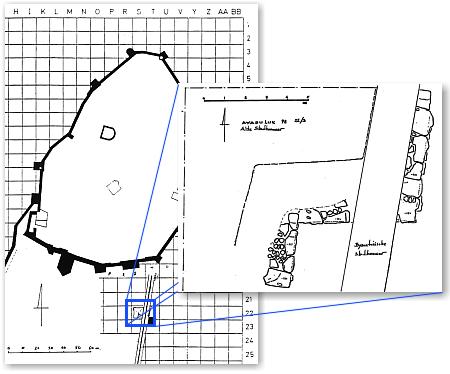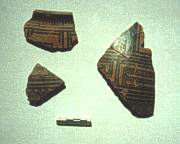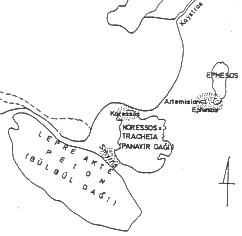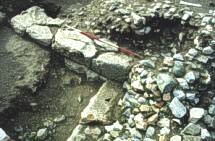EXCAVATION ON AYASULUK HILL IN SELÇUK / TURKEY
A contribution to the early Ephesian history
According to the ancient sources, Ephesus was founded in the second half of the 2nd millenium BC. The first evidence supporting this was unearthed near the Gate of Persecution in 1960 [1]. Before and after this, several theses have been claimed by various scholars, saying that the ancient Ephesus was actually located on Ayasuluk Hill. Besides, suggestions that Apasas, the capital of Arzawa, is actually Ephesus itself have been in question for a long time as well [2].
In the consequence of several excavations during the last decades on the Ayasuluk in SelÁuk / Turkey and especially as a continuation of the researches of 1990, in October-November 1996 a new trench was excavated 40 m to the south of the two trenches dug in 1990.

Fig. 1: Sketch of the Castle of Ayasuluk and the position of the trench
We worked in the eastern half (adjoining the Byzantine fortification) of the trench 22S, which is 8.00 x 8.00 m in size. Here at the depth of 3.30 m, the wall in question, which we already know from earlier excavations, makes a turn left, to the west, and stretches 5.60 m before making another turn, this time to the south. A peculiar point is the existence of a rubble heap, 1.00-1.50 m thick, over and on both sides of this wall (fig. 2-3). It is likely that at the end of the Archaic Period, due to a catastrophe after a heavy rainfall, these rubble stones flooded down here from the area where the inner castle is today. It seems that these rubble stones had been stopped by the ancient fortification [3]. This hypothesis seems to be supported by the facts that, in the Ayasuluk inner castle, there is not much cultural residue left on the main rock and that the Byzantine church was built directly on the main rock.
Fig. 2-3: Fortification unearthed in trench 22S
Though a high amount of Byzantine pottery was found at the upper levels of the trench, none was found in the heap of the rubble stones. Some of the rubble stones were removed and the ancient fortification was exposed. As before, here too, the stone blocks were levelled an the upper and the bottom sides and had a rough, unworked outer face. These limestone blocks are grey in colour and ca. 1.00 m long and 0.50 m high, and were probably procured from the quarry on the north side of Ayasuluk Hill [4]. On the inner part of the wall, which is ca. 3.00 m in width, smaller rubble stones were employed. From the remaining two to three courses of the foundations of this wall, it can be inferred that in the whole the outer faces of the stone blocks were left unworked. Now, we would like to name this wall rather as the fortification of the Hittite city of Apasas, not as a Mycenean fortification as we did before. Besides, this is supported by the pottery found at the bottom level of the fortification as well. However, this layer suggests that there was another landslide here before the construction of this Hittite fortification as well.
 Fig. 4: Late Mycenean pot Fig. 4: Late Mycenean pot
from the trench 22S
|
 Fig. 5: Protogeometric potsherds Fig. 5: Protogeometric potsherds
from the trench 22S
|
In the north-east corner of the trench 22S, which is 4.00 x 4.00 m in size, no architectural traces were found. In the uppermost 2.00 m of the trench, a lot of Byzantine ceramics were found, mixed with just a few pieces of Orientalizing and Geometric Periods. However, between 2.00 m and 3.30 m Archaic, Geometric, and Late Mycenean ceramics were dominant. Amongst these are the Late Mycenean potsherd with spiral motif (fig. 4), and the Protogeometric potsherds with ĺ and semi circle motifs drawn with a compass down to the centerpoint (fig. 5). Moreover, fine quality crater pieces, dated to the 1st half of the 8th century BC (fig. 6), and equals of which have not been found in Miletus and Bayrakli (Smyrna) [5]. A lot of Orientalizing (fig. 7) and Archaic potsherds were recovered as well [6]. Thus, for the first time, the existence of a settlement an Ayasuluk Hill, continuous from the Early Bronze Age up to the Hellenistic Period, has been ascertained. As mentioned above, these ceramics were not gathered from a certain layer but found here due to a landslide probably at the end of the Archaic Period.

Fig. 6: Geometric crater pieces
from the trench 22S
|

Fig. 7: Orientalizing potsherds (may be
from Miletus) from the trench 22S
|
Consequently, it has come into discussion that the Ayasuluk Hill, known to be a Byzantine and Turkish settlement, can actually be the first settlement of Ephesus due to the prehistoric finds unearthed in 1990. Ceramics excavated in 1996 have shown that this settlement continued after the Prehistoric Period through the Hittite, Mycenean, Geometric, and Archaic Periods too.
The author believes that the unearthed potsherds can shed light on the original location of ancient Ephesus.
The location of ancient Ephesus was researched at different times by Austrian scholars like O. Benndorf, J. Keil, A. Bammer, W. Alzinger, W. Oberleitner, F. Brein, S. Karwiese, P. Scherrer and F. Hueber. These researches have melted what Strabo [7] and Pausanias [8] had written with the ceramic finds from Ephesus. These researches, except Benndorf and Keil who are deceased, know about the Mycenean and Prehistoric finds from the Ayasuluk Hill.
The interesting point is that Benndorf, who had researched the location of ancient Ephesus for the first time, has made the best prediction and suggested that ancient Ephesus could be located on the Ayasuluk Hill. Later, Keil's hypothesis, based on the ceramic finds excavated on the western side of Mount Panayir (Koressos) and dated to the 8th century BC, that ancient Ephesus (Koressos) could be located about the stadium, flourished. This point of view, started by Keil, was taken on by Alzinger and by Karwiese, the last.
 Fig. 8: Location of ancient Ephesus,
Fig. 8: Location of ancient Ephesus,
Koressos and Smyrna
|
According to the author, Smyrna and Koressos were parts of ancient Ephesus [9]. Bammer had a different angle of approach and purported that ancient Ephesus was called Koressos and must be located on the Ayasuluk Hill. Bammer thinks that the Gate of Koressos, just like the Gate of Magnesia, must designate a place away from the city and this place must be the Ayasuluk Hill [10]. However, Brein has interpreted the place names mentioned by Strabo and Pausanias the most correctly and purported that ancient Ephesus must be on the Ayasuluk Hill [11]. The paleogeogrphic research done by I. Kayan supports this hypothesis [12].
|
Here, in the Ayasuluk Hill, starting from the Prehistoric period, indigenous people of Anatolia and the Hittites settled down. Later, the city was probably Apasas. About 1050 BC the Hill was captured by Androclus and his men and was started to be called Ephesus by time (fig. 8).
To summerize it can be said that in the Prehistoric Period, in the vicinity of the Ayasuluk Hill there were village type settlements, such as CukuriÁi, Arvalya, HavutÁulu mounds, peculiar to the Early Bronze Age. In the Ionian Period, the same tradition went on with the Ayasuluk Hill - being the ancient Ephesus - taking on the role of the main city surrounded by the port settlements and sacred areas such as Artemision, Smyrna, Koressos, and Orthygia. The Ayasuluk Hill, keeping its main city role until Croesus, lost its importance in the following times. It regained its position in the Byzantine and Turkish Period and is still living as the New Ephesus.
[1] M. Baran - H. GŁltekin, TŁrkAD 13/2, 1964, 122ff.
[2] O. Benndorf, FiE I (1905) 23ff.; A. Bammer, ÷Jh 46, 1961-1963, 136-157; F, Brein, ÷Jh 51, 1976-77, Beibl. 65-76; S. Karwiese, GroŖ ist die Artemis von Ephesos (1995); F. Hueber, Ephesos. Gebaute Geschichte (1997) 30ff.
[3] A similar situation is likely around the wall, dated to the Mycenean Period, excavated in the Artemision as well.
[4] This quarry and the rock tombs nearby were announced by Benndorf for the first time: FiE I (1905) 33 fig, 8. This area, especially the tombs were cleaned by the museum but nothing to help dating them was found. But the tomb with dromos points to a date earlier than the Archaic Period.
[5] I would like to thank M. Kerschner for the information.
[6] In the Artemision excavation (A. Bammer, ÷Jh 60, 1990, 144 Taf. a-e), in the excavations around Koressos (J. Keil, ÷Jh 21-22, 1922-24, 96ff.; J. Keil, ÷Jh 23, 1926, Beibl. 250ff.), in the excavations of Ephesus Lower Agora (Smyrna) (I. Benda, BerMat÷AI 1 [1991]) and in the soundings at the Agora South Gate (V. Gassner, FiE XIII/1/1 [1997]) similar ceramics were found too.
[7] Strabo 14, 1, 21.
[8] Paus. 7, 2, 8.
[9] It is purported that Koressos was part of the New Ephesus (H. Engelmann, ZPE, 115, 1997, 131ff.).
[10] A. Bammer, ÷Jh 46, 1961-1963, 136-157. According to the author, this option is not valid due to the phrase "Koressos in the land of Ephesus" by Herodotus (Hdt. 5, 100).
[11] F. Brein, ÷Jh 51, 1976-77, Beibl. 65-76.
[12] I. Kayan, Arkeometri St 12, 1997.
© Mustafa BŁyŁkkolanci









